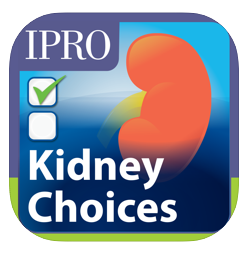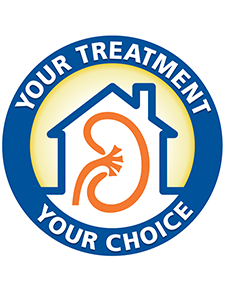Promoting Appropriate Home Dialysis
The IPRO ESRD Network Program promotes a culture of “Home First” to further the "Advancing American Kidney Health Initiative" which aims to achieve 80 percent utilization of home modalities in newly-diagnosed kidney failure patients by 2025. This page provides patients, caregivers, and professional staff credible resources regarding home modalities including tools and educational materials to assist in making treatment modality choices.
Why Home?
It has been scientifically proven that patients who utilize one of the forms of home therapy live longer and with fewer bouts of illness than those who dialyze in a center. However, home dialysis may not be right for everyone, so it is important for patients to gather all information needed and speak with their medical team and others to make a final decision. If a patient determines home therapy is the right choice, he or she will begin a comprehensive training program that is tailored to their specific medical and learning needs. The patient will learn to perform at-home treatments with or without a dialysis care partner and will be released to care for themselves from home once the trainer is confident they have mastered the skills needed to dialyze safely without assistance. Every patient in a home program is provided clinical and technical support 24 hours a day, 7 days a week by phone. Read below to learn more about the different types of home modality treatment options.
Peritoneal Dialysis (PD)
Peritoneal Dialysis, or PD, is a renal replacement therapy where the lining around the abdominal organs, called the peritoneum, is used as a filter or membrane to remove waste products and excess fluid from the blood. It is performed through a peritoneal catheter which is surgically placed in the patient’s abdomen. This can be done using two different approaches and mostly depends on the preference of the patient.
Two Types of Peritoneal Dialysis (PD):
1. Continuous Ambulatory Peritoneal Dialysis (CAPD)
-
- The patient performs an "exchange" manually 4 to 6 times a day based on their lab work and physician orders.
- An exchange occurs when fluid is placed in the abdominal cavity (via a peritoneal dialysis catheter) and is allowed to "dwell" for 3 to 6 hours.
- After the dwell, the fluid is drained from the abdominal cavity and discarded.
- The process is repeated per physician's orders.
2. Continuous Cycling Peritoneal Dialysis (CCPD)
-
- A machine, known as a "cycler," is used to deliver and drain the cleaning fluid to the peritoneum in multiple cycles, or exchanges, while the patient sleeps.
- Treatment times are 8 to 10 hours, encompassing the hours the patient is meant to be sleeping.
Home Hemodialysis (HD)
Home Hemodialysis, or HD, is a renal replacement therapy where blood is removed from the body and filtered through a manmade filter called a dialyzer utilizing a machine. The blood passes through the fibers of the dialyzer which are surrounded by dialysate or cleaning fluid. The excess water and waste pass through the fibers of the dialyzer by means of diffusion to the cleaning fluid and are discarded which cleans the blood of the typical waste products found in the urine. This form of home therapy is very similar to what occurs in a dialysis center except that the machine used is constructed to work very gradually in comparison to a machine in a center and is easy and safe for most anyone to use.
Two Types of Home Hemodialysis (HHD):
1. Home Hemodialysis
-
- This treatment takes place in shorter intervals but more frequently than in-center hemodialysis treatment.
- Treatment times range from 2.5 to 4 hours and are completed 4 to 7 times per week.
2. Nocturnal Home Dialysis
-
- This treatment takes 6 to 8 hours and occurs while the patient is sleeping.
- Patients typically dialyze on nocturnal home dialysis 3 to 5 days per week.
- This treatment requires adequate vascular access to access the patient's blood.
Tools & Resources
Home Dialysis Change Package
- A Change Package to Increase Home Dialysis Use: Guide
- Home Dialysis Heroes: A Home Dialysis Patient Peer Program: Guide
- Nephrologist Regional Roundtable Meetings Implementation: Guide
- Universal Staff Education - Home Dialysis: Learning Modules
Network-Developed Toolkit
- *NEW* Let's Talk About Creating a Pro Home Culture! English
- *NEW* How Old is Too Old for Home Dialysis? English | Spanish
- *NEW* Seeing Yourself In a Positive Light with a Peritoneal Dialysis Catheter: English | Spanish
- Let's Start Health at Home Resource Package Reference Guide: Network 1|Network 2|Network 6|Network 9
- Do you know your home treatment options? Handout
- Do you know all of your treatment options? Home Hemodialysis (HHD) Brochure
- Do you know all of your treatment options? Peritoneal Dialysis (PD) Brochure
- Do Your Patients Know About Home Treatment Options? Handout
- View our Telehealth Toolkit for Providers
Other Resources
- Celebrating Patient Transition to a Home Modality: Poster
- Updating the Patient Treatment Modality in EQRS: Job Aid
- MATCH-D Assessment: Tool
- Know the Facts about Home Dialysis Choices: Guide
- National Kidney Foundation (NKF) - Peer Mentors: Link
- My Life, My Dialysis Choice: Link
- Uncovering Myths About Home Dialysis: Guide
- Patient Stories About Home Dialysis: Link
- Peritoneal Dialysis - What You Need to Know: Booklet
To learn more about treatment options, please visit any of the websites listed below.

Kidney Choices Interactive Mobile Application
The Kidney Choices application is an aide to assist patients and caregivers in learning about their risks for chronic kidney disease (CKD). The application provides a review for your blood work and previous diagnoses (high blood pressure and diabetes) to assess your risk for CKD (Medicare recipients only). It also provides education on different dialysis modality choices.
- Download on the App Store (Apple Users)
- Get it on Google Play (Android Users)

